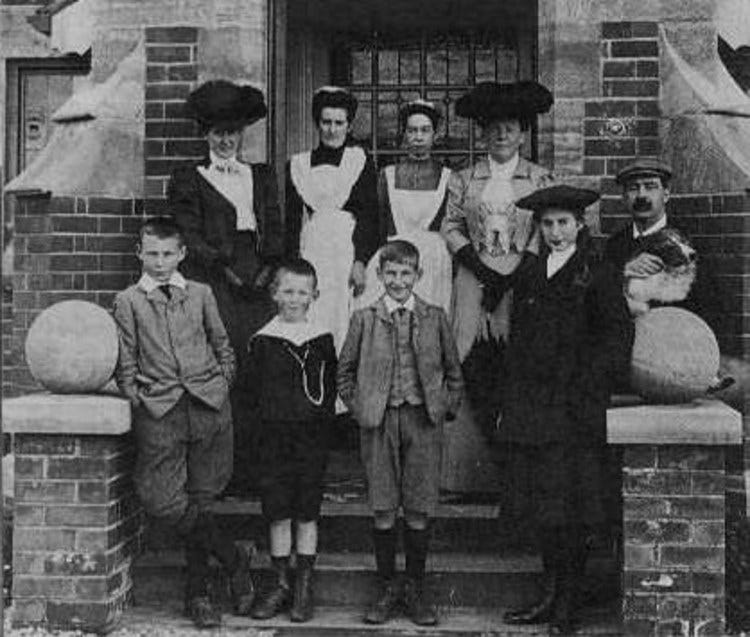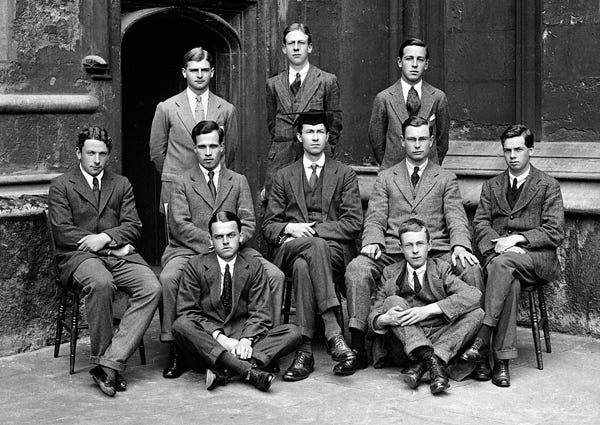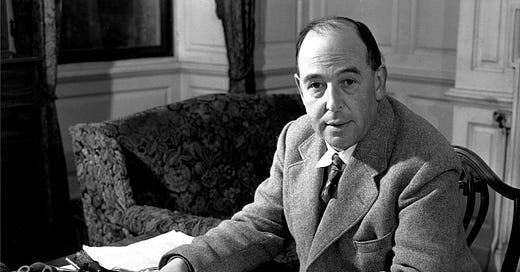Welcome to Beyond Bloomsbury and a bonus post for free subscribers as C. S. Lewis is brought from behind the paywall. To become a Full Member and have access to the complete archive and all future posts, you can subscribe below. Thank you for reading!
C. S. Lewis was a writer, scholar and Christian apologist who wrote almost forty books, including Mere Christianity, Out of the Silent Planet, The Great Divorce, The Screwtape Letters, and his most famous, the classics in The Chronicles of Narnia. In this introductory biography, we will look at the early years of Lewis, from his childhood in Ireland to his membership of Oxford University’s Inklings - a literary group that included his close friend J. R. R. Tolkien. The Inklings will be examined in more detail in a future biography.
Clive Staples Lewis was born into a Christian family at Dundela Villas in Belfast, Ireland, on the 29th of November 1898. His father, Albert James, was a solicitor, and his mother, Flora August Hamilton, graduated in logic and mathematics from the Royal University of Ireland, now Queen’s University, Belfast. His older brother, Warren ‘Warnie’ Hamilton Lewis, had been born three years earlier.
When he was just four years old, Lewis announced that he had changed his name.
Disliking ‘Clive’, and feeling his various baby-names to be beneath his dignity, he marched up to my mother, put a forefinger to his chest, and announced ‘He is Jacksie’. He stuck to this the next day and thereafter, refused to answer to any other name: Jacksie it had to be, a name contracted to Jacks and then Jack.1

In 1905, when he was six years old, Lewis and his family, which included his paternal grandfather Richard Lewis and a variety of pets, moved from Dundela Villas into Little Lea - a brand new home they had built at Strandtown. Albert and Flora were motivated to move due to the poor environmental conditions in the city at that time. Full of smog, a report in 1906 found that Belfast had the highest number of typhoid cases in the UK and was one of the areas at the most significant risk from tuberculosis.
Reading and education were important to Albert and Flora, and Little Lea included an extensive library that Lewis had free use of and would read compulsively.
I had always the same certainty of finding a book that was new to me as a man who walks into a field has of finding a new blade of grass.2
Like his mother, who wrote short stories and articles, Lewis too enjoyed putting his creative imagination to paper, and he claimed a small attic room as his study - a private space separated from the rest of the house by long corridors - which he named The Little End Room. There, inspired by Beatrix Potter, he wrote and illustrated stories of anthropomorphic animals in Animal-Land. Later, he and Warnie created Boxen, a fantasy land inhabited and governed by animals.
Friends, as well as brothers, Lewis and Warnie were inseparable as children, and when they weren’t writing, they would head out into the country on their bicycles. During these golden years at Little Lea, Lewis fell in love with the countryside of County Down, a love that would last throughout his life. Little Lea would also have a lasting influence on him, and he used the house in The Lion, the Witch and the Wardrobe and The Magician’s Nephew, the first and sixth books of The Chronicles of Narnia.
The New House is almost a major character in my story. I am a product of long corridors, empty sunlit rooms, upstair indoor silences, attics explored in solitude, distant noises of gurgling cisterns and pipes, and the noise of wind under the tiles.3
In 1908, when he was just ten years old, his idyllic childhood was shattered by the death of his mother from bowel cancer on the 23rd of August - her husband’s forty-fifth birthday. Two weeks later, his father sent him to Wynyard Boarding School in Watford, England, where Warnie had enrolled the year before.
Wynyard’s headmaster, Reverend Robert Capron, was an authoritarian and a bully who regularly gave his pupils severe beatings. The loss of his mother and his beloved home had a lasting effect on the young Lewis.
With my mother’s death all settled, happiness, all that was tranquil and reliable, disappeared from my life. There was to be much fun, many pleasures, many stabs of joy; but no more of the old security. It was sea and islands now; the great continent had sunk like Atlantis.4
He left Wynyard in June 1910 when Capron, charged with brutality, was sent to an insane asylum, where he died a year later. In September 1910, Lewis enrolled at Campbell College instead. Though the college was just one mile from Little Lea, he joined them as a boarder but, on developing a severe cough, was sent home just two months later.
Rather than return to Campbell, he was sent to Cherbourg House, a prep school and health resort in Malvern, England - close to Malvern College, where Warnie was a student.
Warnie and I arrived safely at Malvern after a splendid journey. Cherbourg is quite a nice place. There are 17 chaps here. There are three masters, Mr Allen, Mr Palmer and Mr Jones, who is very fat… Malvern is one of the nicest English towns I have seen yet. The hills are beautiful, but of course not so nice as ours.5
He appears to have enjoyed his time at Cherbourg and writes in Surprised By Joy that he learned about friendship there but also lost his childhood Christian faith.
… dropping my faith with no sense of loss but with the greatest relief.6
In September of 1913, Lewis left Cherbourg for Malvern College. Warnie, an outgoing and sporty boy, had made friends there, but Lewis, an introvert whose only real friend was his brother, was bullied by the other boys and pleaded with his father to remove him.
Not only does this persecution get harder to bear as time goes on, but it is actually getting more severe… Please take me out of this as soon as possible, but don’t, whatever you do, write to the James or the Old Boy,’ as that would only make things worse.7
Eventually, in Spring 1914, Albert relented and arranged for him to study with W. T. Kirkpatrick, a private tutor in Great Bookham, Surrey, who had taught both Albert and Warnie. Though Albert wanted him to remain at Malvern until it was time to enrol with ‘The Great Knock’ as Kirkpatrick became known, Lewis returned home to Little Lea, where he made his first true friend.
Arthur Greeves was the youngest of five children of Albert’s closest neighbours. Although he and Lewis had known each other most of their lives, it wasn’t until April 1914 that their friendship developed when Lewis visited Arthur, who was ill in bed. The two boys shared many common interests and would see one another regularly and correspond throughout their lives, with Lewis writing almost three hundred letters.
After my brother, my oldest and most intimate friend.8
Lewis left for Great Bookham and Kirkpatrick’s schooling on the 19th of September, and on the 26th, he wrote to Albert.
After a week’s trial, I have come to the conclusion that I am going to have the time of my life.9
He remained with Kirkpatrick for two and a half years and became very fond of the man who supported him intellectually and emotionally and prepared him for a future in academia. Years later, he recreated his beloved teacher as MacPhee in That Hideous Strength.
Kirkpatrick and Albert agreed that Lewis should apply to Oxford University, but it was 1916, two years into the First World War, and though, as an Irishman, he was exempt from conscription, he wanted to serve. In December 1916, he travelled to Oxford to take his scholarship examination. He enrolled at the university in the Trinity Term of 1917, joining the Army through the University Officer’s Training Corps.
This place has surpassed my wildest dreams. I have never seen anything so beautiful, especially on the frosty moonlight nights.10
He lived at University College until his assignment to a cadet battalion in June. Happily, he could stay in Oxford and was billeted at Keble College, where he lived alongside Edward Francis Courtenay ‘Paddy’ Moore from Clifton College. The two soon became friends and made an informal contract that should one die in battle, the other would care for his family.
On the 16th of October, Lewis joined the 3rd Battalion, Somerset Light Infantry, and by his nineteenth birthday, the 29th of November, was on the front line at the Somme. Paddy was killed in action, and, true to his word, Lewis reached out to Paddy’s mother, Janie King Moore, on his return. A complex relationship began, developing from friendship to maternal and then sexual. Lewis moved in with Janie and her daughter Maureen, and the relationship with a woman twenty-seven years his senior concerned both Albert and Warnie.
I confess I do not know what to do or say about Jack’s affair. It worries and depresses me greatly. All I know about the lady is that she is old enough to be his mother - that she is separated from her husband and that she is in poor circumstances.11
In January 1919, Lewis returned to his studies at University College, Oxford. He settled into a happy routine of lectures or reading at the library in the mornings, afternoons with Mrs. Moore, and evenings spent in private study.
It was a great return and something to be thankful for. There is of course already a great difference between this Oxford and the ghost I knew before… The reawakening is a little pathetic: at our first J.C.R. Meeting we read the minutes of the last - 1914. I don’t know any little thing that has made me realise the absolute suspension and waste of these years more thoroughly.12
He graduated from Oxford with three first-class degrees: in Greek and Latin Literature in 1920, Philosophy and Ancient History in 1922, and English in 1923.

Following graduation, Lewis struggled to become a Fellow until he was asked to deputise, during the 1924-25 academic year, for philosophy tutor E. F. Carritt. In May, he was then elected to a fellowship in English at Magdalen College. At Magdalen, he joined the now-famous Inklings, a group of intellectuals and writers.
The Inklings would meet regularly to discuss literature and read aloud their work - occasionally in their college rooms. However, they could often be found at the Eagle and Child on Tuesday mornings and the Lamb and Flag on Thursday evenings. Other early group members included his brother Warnie, Owen Barfield, Hugo Dyson, Charles Williams and J. R. R. Tolkien.
It was to The Inklings that Tolkien and Lewis first read aloud The Lord of the Rings and The Lion, the Witch and the Wardrobe.
And that is the very end of the adventure of the wardrobe. But if the Professor was right, it was only the beginning of the adventures of Narnia.13
Thank you for reading! If you enjoyed this biography, please like and/or share. And, as always, I would love to know your thoughts in the comments. If you wish, you can also join the Bloomsbury Salon and/or read the suggested Beyond Bloomsbury posts below. Until next time…
Images:
Images on Beyond Bloomsbury are usually credited. I conduct thorough picture research, but please let me know if you believe a credit needs to be added or corrected. Thank you!
Sources and Recommended Reading:
Carpenter, Humphrey, The Inklings (Harper Collins, 2006)
Como, James, Remembering C. S. Lewis: Recollections of Those Who Knew Him (Ignatius Press, 2005)
Edwards, Bruce, C. S. Lewis: Life, Works, and Legacy (Praeger Publishers, 2007)
ed. Ford, Paul F., Yours, Jack (HarperOne, 2008)
ed. Hooper, Walter, Collected Letters of C. S. Lewis: Volume One, Family Letters 1905-1931 (HarperOne, 2000)
ed. Kilby, Clyde S and Mead, Marjorie Lamp, Brothers and Friends: The Diaries of Major Warren Hamilton Lewis (Joanna Cotler Books, 1982)
Lancelyn Green, Roger and Hooper, Walter, C. S. Lewis: The Authorised and Revised Biography (Harper Collins, 2003)
Lewis, C. S., Surprised By Joy (HarperOne, 2016)
Lewis, C. S., The Lion, the Witch and the Wardrobe (Geoffrey Bles, 1950)
McGrath, Dr Alister., C. S. Lewis: A Life (Hodder & Stoughton, 2013)
Poe, Harry Lee, Becoming C. S. Lewis: A Biography of Young Jack Lewis (1898-1918) (Crossway, 2019)
Wilson, A.N., C. S. Lewis: A Biography (Harper Collins, 2005)
Clyde S Kilby and Marjorie Lamp Mead, Brothers and Friends: The Diaries of Major Warren Hamilton Lewis (Joanna Cotler Books, 1982)
Roger Lancelyn Green and Walter Hooper, C. S. Lewis: The Authorised and Revised Biography (Harper Collins, 2003), p. 2.
C. S. Lewis, Surprised By Joy (HarperOne, 2016), p. 6.
Lewis, pp. 14-15.
ed. Walter Hooper, Collected Letters of C. S. Lewis: Volume One, Family Letters 1905-1931 (HarperOne, 2000), p. 16.
Lewis, p. 49.
Hooper, pp. 50-51.
Lancelyn Green and Hooper, p. 23.
Hooper, p. 70.
Hooper, p. 262.
Lancelyn Green and Hooper, p. 52.
Hooper, p. 428.
Lewis, C. S., The Lion, the Witch and the Wardrobe (Geoffrey Bles, 1950)









